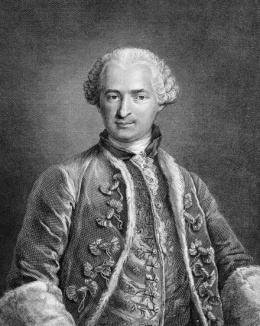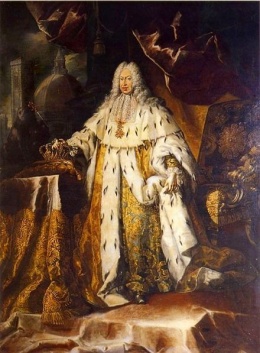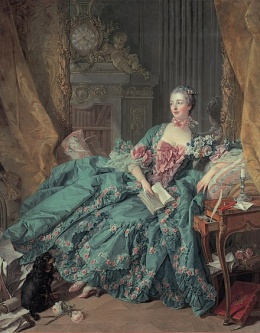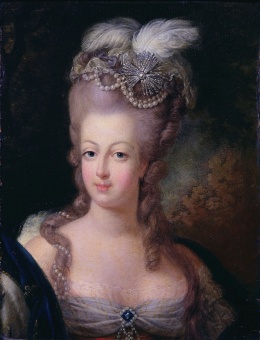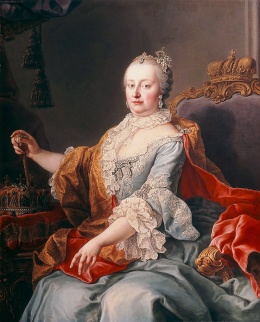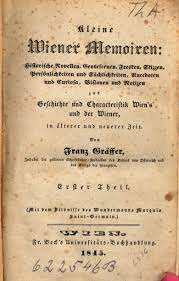Count de Saint Germain
The Count de Saint Germain was an 18th century European aristocrat of unknown origin. He had no visible means of support, but no lack of resources, and moved in high social circles. He was a renowned conversationalist and a skilled musician. He dropped hints that he was centuries old and could grow diamonds. He was ambidextrous, and as far as anyone could tell, totally celibate. He served as a backchannel diplomat between England and France and may have played some role in Freemasonry. He hobnobbed with Marie Antoinette, Catherine the Great, Voltaire, Rousseau, Mesmer, and Casanova. He dabbled in materials and textile technology as well as alchemy. [1] His birth and background are obscure, but towards the end of his life he revealed that he was a son of Prince Francis Rákóczy of Transylvania. [2]
He was one of the Masters of the Wisdom, also known as "The Master, The Prince." He is associated with the seventh ray, and ceremonial magic. Human incarnations attributed to him include Saint Alban (third century C.E.), Proclus (a Neoplatonic philosopher, 410-85 C.E.), Roger Bacon (1220-92), Christian Rosenkreutz (1378-1484), Hunyadi Janos (1387-1456), Robertus the monk (sixteenth century), and Francis Bacon (1561-1626).
Early Years
Count de St. Germain was probably born as Leopold Georg Rákóczi as the first son of the Transylvanian Prince Franz II Rákóczi and the German Princess Amalie Charlotte of Hesse-Rheinfels at the castle of Sárospatak (or at Topoľčianky Castle). Francis II Rákóczi strove for independence from the Habsburgs, who harshly oppressed the country, and planned an uprising. Concerned for the safety of his firstborn son, a false death certificate was issued in 1700 for the then four-year-old boy. In a roundabout way, he was brought to Florence to Gian Gastone de' Medici, the last Grand Duke of Tuscany from the House of Medici, where he was educated together with the Infante Carlos of Spain. Before attending the princely school in Siena, Leopold George was confirmed, taking the name San Germano (Italian for Holy Brother), which was, however, changed to Saint-Germain after the suggestion of Gian de Medici after the old Château Saint Germain-en-Laye near Paris. [3] [4]
In Siena he was introduced to the secrets of alchemy and Hermetic wisdom by a goldsmith. In 1715, the young count secretly left the boarding school in Siena and embarked on extensive travels that took him first to Central America, where he studied the culture of the Maya and Aztecs. From there he went to Lisbon and on to Turkey, Persia, and Malta. [5]That he had also traveled to Africa, India and China could be gathered from various hints he gave, and also from facts stated by many writers at different times. [6]
Courting European Society
The first historical trace of the Count de St. Germain seems to be a letter written on November 22nd, 1735, in The Hague in the Dutch Republic signed with ‘P.M. de Saint-Germain’. It is addressed to the Irish physician and collector Sir Hans Sloane and offered to procure for him a printed copy of the Catholicon (an encyclopedic Latin dictionary). A Frenchman by the name of Morin, who was then ambassador to The Hague, said he had met St. Germain there in 1735, and that when he met him again in France in the late 1750s, he was astonished to find that Saint-Germain did not seem to have aged by so much as a year. [7] Count de St. Germain came into prominence in the high society of Europe in 1742. He had just spent five years in the Shah of Persia's court where he had learned the jeweler's craft. He impressed the royals and the rich with his vast knowledge of science and history, his musical ability, his easy charm, and quick wit. He spoke many languages fluently, including French, German, Dutch, Spanish, Portuguese, Russian and English, and was further familiar with Chinese, Latin, Arabic — even ancient Greek and Sanskrit.[8][9] His charming personality made him a welcome guest in the homes of the nobility of every land. But while he often sat at table with his friends, his own food was specially prepared for him in his own apartments. He ate no meat and drank no wine, his favorite beverage being a tea which he prepared from certain herbs, and which he frequently presented to his friends. His extraordinary popularity was due to his prowess as a raconteur, to his well-known intimacy with the greatest men and women of the day, to his familiarity with occult subjects, and especially to the mystery of his birth and nationality, which he consistently refused to reveal. [10]
Count de St. Germain has been described as of medium height, well-proportioned and of regular and pleasing features. He dressed simply, usually in black, but his clothes were well fitting and of the best quality. His eyes possessed a great fascination and those who looked into them were profoundly influenced. According to Madame de Pompadour, the official mistress of King Louis XV, he claimed to possess the secret of eternal youth, and upon a certain occasion claimed having been personally acquainted with Cleopatra, and at another time of having "chatted familiarly with the Queen of Sheba"![11]
England and Music
The Count turns up in England in 1745 and contributed some of the songs to L'incostanza delusa, an opera performed at the Haymarket Theatre in London. Later, in a letter of December of that same year, Horace Walpole, a young Whig politician, mentions Count de St. Germain as being arrested in London on suspicion of espionage during the Jacobite rebellion of 1745, but released without charge: [12][13]
Whatever the main purpose of Saint-Germain’s stay in England, he made a great impression as a musician. After 1745, Saint-Germain’s precise whereabouts and activities for the next 12 years are uncertain. His own statements indicate that he was probably developing various manufacturing techniques in Germany, mainly in the area of dyeing. In 1755 he was involved in promoting a machine invented by a Frenchman for cleaning and deepening ports, estuaries, and waterways, and made a trip to The Hague in late 1755 or early 1756. [14][15]
The French Court
Count de St. Germain entered France during the summer or early autumn of 1757. At that time France was ruled by Louis XV. Louis, who had enjoyed a favorable reputation at the start of his reign in 1715 but became extremely unpopular due to the extravagance of his court and his ill-advised financial policies. He was uninterested in politics and largely influenced by his chief mistress, Madame de Pompadour and his decisions damaged the power of France. The Count wrote a letter to the King, offering to donate money and asking to use a royal residence for free. He also felt that his dyeing and other techniques could help increase national wealth. He was granted by May 1758 to use several suites at the Chateau Chambord [16] In 1760 Louis sent the Count de St. Germain on a delicate diplomatic mission to The Hague and London. [17] According to local records, the Count died in Prince Charles of Hesse-Cassel’s castle at Eckenförde. on February 27, 1784. [18] But there are no particulars of the last hours of the mysterious Count. According to H. P. Blavatsky, it is absurd to suppose that he really died at the time and place mentioned without having been laid to rest without the pomp and ceremony, the official supervision, the police registration which attend the funerals of men of his rank and notoriety. [19]
Howsoever, he continued to be seen afterwards. This fact is brought out in the Souvenirs de Marie-Antoinette, written by one of her ladies-in-waiting, the Countess d'Adhémar. This diary was started in 1760 and ended in 1821, one year before the death of the Countess, and a large part of it is concerned with St. Germain's efforts to avert the horrors of the French Revolution. Early one Sunday morning in 1788 the Countess was surprised to receive a visit from the Count de St. Germain, whom she had not seen in several years. He warned her that a giant conspiracy was under foot, in which the Encyclopaedists would use the Duc de Chartres in an effort to overthrow the monarchy and asked her to take him to the Queen. When Madame d'Adhémar reported the conversation to Marie-Antoinette, the Queen confessed that she also had received another communication from this mysterious stranger who had protected her with warnings from the day of her arrival in France. On the following day St. Germain was admitted into the private apartments of the Queen. "Madame," he said to her, "for twenty years I was on intimate terms with the late King, who deigned to listen to me with kindness. He made use of my poor abilities on several occasions, and I do not think he regretted giving me his confidence." After warning her of the serious condition of France, he asked her to communicate his message to the King and to request the King not to consult with Maurepas. But the King ignored the warning, and went directly to Maurepas, who immediately called upon Madame d'Adhémar. In the midst of the conversation St. Germain appeared. He confronted Maurepas with his treachery and said to him: "In opposing yourself to my seeing the monarch, you are losing the monarchy, for I have but a limited time to give to France. This time over, I shall not be seen here again, until after three successive generations have gone down to the grave." The second warning from St. Germain came on July 14, 1789, when the Queen was saying farewell to the Duchesse de Polignac. She opened the letter and read: "My words have fallen on your ears in vain, and you have reached the period of which I informed you. All the Polignacs and their friends are doomed to death. The Comte d'Artois will perish." His farewell letter, addressed to Madame d'Adhémar, arrived on October 5, 1789. "All is lost, Countess!" he wrote. "This sun is the last which will set on the monarchy. Tomorrow it will exist no more. My advice has been scorned. Now it is too late. . . ." In that letter he asked the Countess to meet him early the next morning. In that conversation the Count de St. Germain informed her that the time when he could have helped France was past. "I can do nothing now. My hands are tied by one stronger than myself. The hour of repose is past, and the decrees of Providence must be fulfilled." He foretold the death of the Queen, the complete ruin of the Bourbons, the rise of Napoleon. "And you yourself?" the Countess asked. "I must go to Sweden," he answered. "A great crime is brewing there, and I am going to try to prevent it. His Majesty Gustavus III interests me. He is worth more than his renown." The Countess inquired if she would see him again. "Five times more," he answered. "Do not wish for the sixth." [20]
Rosicrucianism and Freemasonry
The Rosicrucian organizations were certainly helped by him. While Christian Rosenkreutz, the founder of the Order, transmitted his teachings orally, St. Germain recorded the doctrines in figures, and one of his enciphered manuscripts became the property of his staunch friend, Prince Karl von Hesse. H.P.B. mentions this manuscript in The Secret Doctrine (vol. II, 1888, page 202) and quotes at length from another (vol. II, 1888, page 582). While St. Germain was living in Vienna, he spent much of his time in the Rosicrucian laboratory on the Landstrasse, and at one time lived in the room which Leibniz occupied in 1713. St. Germain also worked with the Fratres Lucis, and with the "Knights and Brothers of Asia" who studied Rosicrucian and Hermetic science. [21]
The Count de St. Germain has been generally regarded as an important figure in early activities of Freemasons. Repeated efforts, however, have been made to discredit his Masonic affiliations. [22] Careful research into Masonic archives prove that he occupied a prominent position in eighteenth century Masonry. He acted as a delegate to the Wilhelmsbad Convention in 1782 and to the great Paris Convention of 1785. Cadet de Gassicourt described him as a travelling member of the Knights Templar, and Deschamps says that Cagliostro was initiated into that Order by St. Germain. [23]
Promoting Unity of Europe
The Count was a genius when it came to grasping the political situation of Europe and the consummate skill with which he parried the thrusts of his diplomatic adversaries. At all times he bore credentials which gave him entry to the most exclusive circles of European nobility. [24] He was also a determined champion of social thought. He renewed old religious traditions and strove to promote the unity of Europe as the basis of a lasting peace order wherever he could. However, caution was always the order of the day, and secrecy his guiding principle. [25][26]
In 1747, he received a secret mission from Empress Maria Theresa from Austria to conduct peace talks with the Duke of Cumberland in Flanders. On October 18, 1748, the Peace of Aachen was concluded. In 1759-1760 the Count stayed in Chambord and produced artificial diamonds for King Louis XV and acted in The Hague as secret peace negotiator for the king. [27] [28] Count de St. Germain was in St. Petersburg at the time of Peter III., during the palace revolution in 1762, and left when Catherine II. came to the throne. By the Tsarina Catherine II he was appointed a general and honored with the title and name Count Soltikov. [29] [30] Very forcefully, the Count of Saint-Germain warned of the dangers that were to break out soon after in the form of the French Revolution, by which the spiritual impulses of liberty, equality, and fraternity, which were correct in themselves, were tumultuously mixed together and distorted beyond recognition. [31] [32]
Death
The Count de St. Germain is said to have died on February 27, 1784, and the Church Register of Eckernförde in Danish Holstein contains the record of his death and burial. But as mentioned above (The French Court), some of St. Germain's most important work was done after that date. [33]
Moreover, in the last decade of the eighteenth century St. Germain confided his future plans to his Austrian friend, Franz Gräffer, [34] saying:
Tomorrow night I am off. I am much needed in Constantinople, then in England, there to prepare two new inventions which you will have in the next century -- trains and steamboats. […] Toward the end of this century, I shall disappear out of Europe and betake myself to the region of the Himalayas. I will rest; I must rest. Exactly in 85 years will people again set eyes on me. Farewell. [35]
These words were spoken in 1790. Eighty-five years from that date brings us to 1875. What part did St. Germain play in the Theosophical Movement of last century? What part is he going to play in the present century? H.P.B. gave a cryptic suggestion of the time when he would again appear.
The Count de St. Germain was certainly the greatest Oriental Adept Europe had seen during the last centuries. But Europe knew him not. Perchance some may recognize him at the next Terreur, which will affect all Europe when it comes, and not one country alone. [36]
Col. Olcott wrote in 1905, that he believed that both St-Germain and H. P. Blavatsky were messengers and agents of the White Lodge. Her further wrote, “The one was sent to help in directing the convergent lines of karma that were to bring about the political cataclysm of the 18th century with all its appalling consequences, to let loose the moral cyclone which was to purify the social atmosphere of the world; the other came at a time when materialism was to meet its Waterloo and the new reign of spiritual high-thinking was to be ushered in through the agency of our Society.” [37]
Moreover, Count de St. Germain was thoroughly conversant with the principles of Oriental esotericism. He practiced the Eastern system of meditation and concentration, upon several occasions having been seated with his feet crossed and hands folded in the posture of a Hindu Buddha. He had a retreat in the heart of the Himalayas to which he retired periodically from the world. And at various times he admitted that he was obeying orders of a power higher and greater than himself. [38]
Quotes from Helena Blavatsky
Madame Blavatsky wrote about the Count numerous times and the excerpts can be found in her Collected Writings online: [39]
…together with Mesmer and Count de Saint-Germain, to the Lodge of the Philalethes. (vol. XII, page 84)
……he thorough metamorphosis of nearly the whole of the European map, beginning with the French Revolution of ’93, predicted in every detail by the Count de St.-Germain, in an autograph MS., now in possession of the descendants of the Russian nobleman to whom he gave it, and coming down to the Franco-Prussian War of the latter days. (vol. I, page 107)
Thus, magic exists and has existed ever since prehistoric ages. Begun in history with the Samathracian mysteries, it followed its course uninterruptedly, and ended for a time with the expiring theurgic rites and ceremonies of christianized Greece; then reappeared for a time again with the Neo-Platonic, Alexandrian school, and passing, by initiation, to sundry solitary students and philosophers, safely crossed the mediaeval ages, and notwithstanding the furious persecutions of the Church, resumed its fame in the hands of such adepts as Paracelsus and several others, and finally died out in Europe with the Count de St.-Germain and Cagliostro, to seek refuge from the frozen-hearted skepticism in its native country of the East. (vol I, page 141)
For centuries the selection of Chelas—outside the hereditary group within the gon-pa (temple)—has been made by the Himalayan Mahatmas themselves from among the class—in Tibet, a considerable one as to number—of natural mystics. The only exceptions have been in the cases of Western men like Fludd, Thomas Vaughan, Paracelsus, Pico della Mirandola, Count de Saint-Germain, etc., whose temperamental affinity to this celestial science more or less forced the distant Adepts to come into personal relations with them, and enabled them to get such small (or large) proportion of the whole truth as was possible under their social surroundings. (vol. IV, page 607)
The exceptions to this quasi universal rule have been hitherto found only in some rare cases of constitutional, abnormally precocious individual evolutions; or, in such, where by early training and special methods, reaching the stage of the 5th rounders, some men in addition to the natural gift of the latter have fully developed (by certain occult methods) their sixth, and in still rarer cases their seventh, sense. As an instance of the former class may be cited the Seeress of Prevorst; a creature born out of time, a rare precocious growth, ill adapted to the uncongenial atmosphere that surrounded her, hence a martyr ever ailing and sickly. As an example of the other, the Count St. Germain may be mentioned. Apace with the anthropological and physiological development of man runs his spiritual evolution. (vol. V, pp. 144-145)
Nevertheless, it is our firm conviction based on historical evidence and direct inferences from many of the Memoirs of those days that the French Revolution is due to one Adept. It is that mysterious personage, now conveniently classed with other “historical charlatans” (i. e. great men whose occult knowledge and powers shoot over the heads of the imbecile majority), namely, the Count de St. Germain—who brought about the just outbreak among the paupers, and put an end to the selfish tyranny of the French kings—the “elect, and the Lord’s anointed.” And we know also that among the Carbonari—the precursors and pioneers of Garibaldi there was more than one Freemason deeply versed in occult sciences and Rosicrucianism. (vol. VI, pp. 19-20)
The “Count de Saint-Germain” is, until this very time, a living mystery, and the Rosicrucian Thomas Vaughan another one. (vol. I, p. 109)
We may then, strengthen our arguments by giving a few sentences from a curious manuscript belonging to a Fellow of the Theosophical Society in Germany, a learned mystic, who tells us that the document is already on its way to India. It is a sort of diary, written in those mystical characters, half ciphers, half alphabet, adopted by the Rosicrucians during the previous two centuries, and the key to which, is now possessed by only a very few mystics. Its author is the famous and mysterious Count de Saint-Germain; he, who before and during the French Revolution puzzled and almost terrified every capital of Europe, and some crowned Heads; and of whom such a number of weird stories are told. All comment now would be premature. The bare suggestion of there being anything more mysterious than a blind “freak” of nature in this particular find, is calculated to raise a scornful laugh from every quarter, with the exception, perhaps, of some Spiritualists and their natural allies, the Theosophists. (vol. II, pp 193-194)
One other point should be noticed. The above account gives no particulars of the last hours of the mysterious Count or of his funeral. Is it not absurd to suppose that if he really died at the time and place mentioned, he would have been laid in the ground without the pomp and ceremony, the official supervision, the police registration which attend the funerals of men of his rank and notoriety? Where are these data? He passed out of public sight more than a century ago, yet no memoir contains them. A man who so lived in the full blaze of publicity could not have vanished, if he really died then and there, and left no trace behind. Moreover, to this negative we have the alleged positive proof that he was living several years after 1784. He is said to have had a most important private conference with the Empress of Russia in 1785 or 1786, and to have appeared to the Princesse de Lamballe when she stood before the tribunal, a few moments before she was struck down with a bullet, and a butcher-boy cut off her head; and to Jeanne du Barry, the mistress of Louis XV, as she waited on her scaffold at Paris the stroke of the guillotine in the Days of Terror, of 1793. A respected member of our Society, residing in Russia, possesses some highly important documents about the Count de Saint-Germain, and for the vindication of the memory of one of the grandest characters of modern times, it is hoped that the long-needed but missing links in the chain of his chequered history, may speedily be given to the world through these columns. (vol. III, p. 129)
Additional resources
Articles
- Saint Germain, Comte De at Theosophy World
- Count St. Germain by H. P. Blavatsky
- The Count of Saint-Germain by David Pratt
- Count de Saint Germain by H.S. Olcott
- The Count de Saint Germain at WisdomWorld.org
- Hall, Manly P. "Comte de St.-Germain." Collected Writings of Manly P. Hall Volume 2: Sages and Seers (Los Angeles: Philosophical Research Society, Inc., 1959), 213-241.
Notes
- ↑ Cooper-Oakley, Isabel. The Comte de St. Germain.1912. https://www.sacred-texts.com/sro/csg/index.htm. Accessed on 5/2/23
- ↑ Pratt, David.The Count of Saint-Germain.2012. http://davidpratt.info/st-germain1.htm Accessed on 5/2/23
- ↑ ANTHRO WIKI. Graf von Saint Germain https://anthrowiki.at/Graf_von_Saint-Germain Accessed on 5/4/23
- ↑ Cooper-Oakley, Isabel. The Comte de St. Germain.1912. https://www.sacred-texts.com/sro/csg/csg02.htm. Accessed on 5/2/23
- ↑ ANTHRO WIKI. Graf von Saint Germain https://anthrowiki.at/Graf_von_Saint-Germain Accessed on 5/4/23
- ↑ Cooper-Oakley, Isabel. The Comte de St. Germain.1912. https://www.sacred-texts.com/sro/csg/csg02.htm. Accessed on 5/2/23
- ↑ Pratt, David.The Count of Saint-Germain.2012. http://davidpratt.info/st-germain1.htm Accessed on 5/2/24
- ↑ Wagner, Stephen. Saint-Germain: The Immortal Count https://www.liveabout.com/saint-germain-the-immortal-count-2594421 Accessed on 5/3/2023
- ↑ Comte de Saint-Germain.The Most Holy Trinosophiahttps://www.sacred-texts.com/eso/mht/mht02.htm. Accessed on 5/4/23
- ↑ GREAT THEOSOPHISTS.The Count de St. Germain THEOSOPHY, Vol. 27, No. 1, November, 1938. (Pages 3-9); (Number 28 of a 29-part series) https://blavatsky.net/Wisdomworld/setting/germain.html Accessed on 5/3/2023
- ↑ Comte de Saint-Germain.The Most Holy Trinosophiahttps://www.sacred-texts.com/eso/mht/mht02.htm. Accessed on 5/2/23
- ↑ Hunter, David. Monsieur le Comte de Saint-Germain: The Great PretenderThe Musical Times, Winter, 2003, Vol. 144, No. 1885 (Winter, 2003), pp. 40-44. Accessed through JSTOR.
- ↑ Pratt, David.The Count of Saint-Germain.2012. http://davidpratt.info/st-germain1.htm Accessed on 5/4/24
- ↑ Pratt, David.The Count of Saint-Germain.2012. http://davidpratt.info/st-germain1.htm Accessed on 5/4/24
- ↑ Fuller, Jean. The Comte de Saint Germain: Last scion of the House of Rákóczy. London: East-West Publication, 1988, pp. 89, 95-96
- ↑ Pratt, David.The Count of Saint-Germain.2012. http://davidpratt.info/st-germain1.htm Accessed on 5/4/24
- ↑ GREAT THEOSOPHISTS.The Count de St. Germain THEOSOPHY, Vol. 27, No. 1, November, 1938. (Pages 3-9); (Number 28 of a 29-part series) https://blavatsky.net/Wisdomworld/setting/germain.html Accessed on 5/3/2023
- ↑ Wagner, Stephen. Saint-Germain: The Immortal Count https://www.liveabout.com/saint-germain-the-immortal-count-2594421 Accessed on 5/3/2023
- ↑ Blavatsky, H.P. Count St. GermainCollected Writings, vol. II, number 8, May 1881. https://www.blavatsky.net/index.php/count-st-germain Accessed on 5/5/23
- ↑ GREAT THEOSOPHISTS.The Count de St. Germain THEOSOPHY, Vol. 27, No. 1, November, 1938. (Pages 3-9); (Number 28 of a 29-part series) https://blavatsky.net/Wisdomworld/setting/germain.html Accessed on 5/3/2023
- ↑ GREAT THEOSOPHISTS.The Count de St. Germain THEOSOPHY, Vol. 27, No. 1, November, 1938. (Pages 3-9); (Number 28 of a 29-part series) https://blavatsky.net/Wisdomworld/setting/germain.html Accessed on 5/3/2023
- ↑ Hall, Manly. The Secret Teachings of all Ages Kindle Edition.
- ↑ GREAT THEOSOPHISTS.The Count de St. Germain THEOSOPHY, Vol. 27, No. 1, November, 1938. (Pages 3-9); (Number 28 of a 29-part series) https://blavatsky.net/Wisdomworld/setting/germain.html Accessed on 5/3/2023
- ↑ Comte de Saint-Germain.The Most Holy Trinosophiahttps://www.sacred-texts.com/eso/mht/mht02.htm. Accessed on 5/4/23
- ↑ ANTHRO WIKI. Graf von Saint Germain https://anthrowiki.at/Graf_von_Saint-Germain Accessed on 5/4/23
- ↑ Feuerstack, Aljoscha.Graf St.-Germainhttps://st-germain.de/biographie/kurzbiographie/friedensbemuehungen/ Accessed on 5/3/23
- ↑ Feuerstack, Aljoscha.Graf St.-Germainhttps://st-germain.de/biographie/kurzbiographie/friedensbemuehungen/ Accessed on 5/3/23
- ↑ ANTHRO WIKI. Graf von Saint Germain https://anthrowiki.at/Graf_von_Saint-Germain Accessed on 5/4/23
- ↑ Cooper-Oakley, Isabel. The Comte de St. Germain.1912. https://www.sacred-texts.com/sro/csg/csg02.htm. Accessed on 5/2/23
- ↑ ANTHRO WIKI. Graf von Saint Germain https://anthrowiki.at/Graf_von_Saint-Germain Accessed on 5/4/23
- ↑ ANTHRO WIKI. Graf von Saint Germain https://anthrowiki.at/Graf_von_Saint-Germain Accessed on 5/4/23
- ↑ Cooper-Oakley, Isabel. The Comte de St. Germain.1912. https://www.sacred-texts.com/sro/csg/csg02.htm. Accessed on 5/2/23
- ↑ GREAT THEOSOPHISTS.The Count de St. Germain THEOSOPHY, Vol. 27, No. 1, November, 1938. (Pages 3-9); (Number 28 of a 29-part series) https://blavatsky.net/Wisdomworld/setting/germain.html Accessed on 5/3/2023
- ↑ GREAT THEOSOPHISTS.The Count de St. Germain THEOSOPHY, Vol. 27, No. 1, November, 1938. (Pages 3-9); (Number 28 of a 29-part series) https://blavatsky.net/Wisdomworld/setting/germain.html Accessed on 5/3/2023
- ↑ Gräffer, Franz. Kleine Wiener Memorien1845. Page 149. https://www.digitale-sammlungen.de/de/view/bsb10727070?page=158 Accessed on 5/3/23
- ↑ GREAT THEOSOPHISTS.The Count de St. Germain THEOSOPHY, Vol. 27, No. 1, November, 1938. (Pages 3-9); (Number 28 of a 29-part series) https://blavatsky.net/Wisdomworld/setting/germain.html Accessed on 5/3/2023
- ↑ Olcott, H.S. Count de Saint Germain – Two Messengers of the White Lodge.. The Theosophist, July 1905. Reprinted in the Quest magazine: https://www.theosophical.org/component/content/article/65-olcott/1864# Accessed on 5/5/23
- ↑ Hall, Manly. The Secret Teachings of all Ages Kindle Edition.
- ↑ Hellelink, Katinka. H.P.Blavatsky. Collected Writings Online. Index. http://www.katinkahesselink.net/blavatsky/
